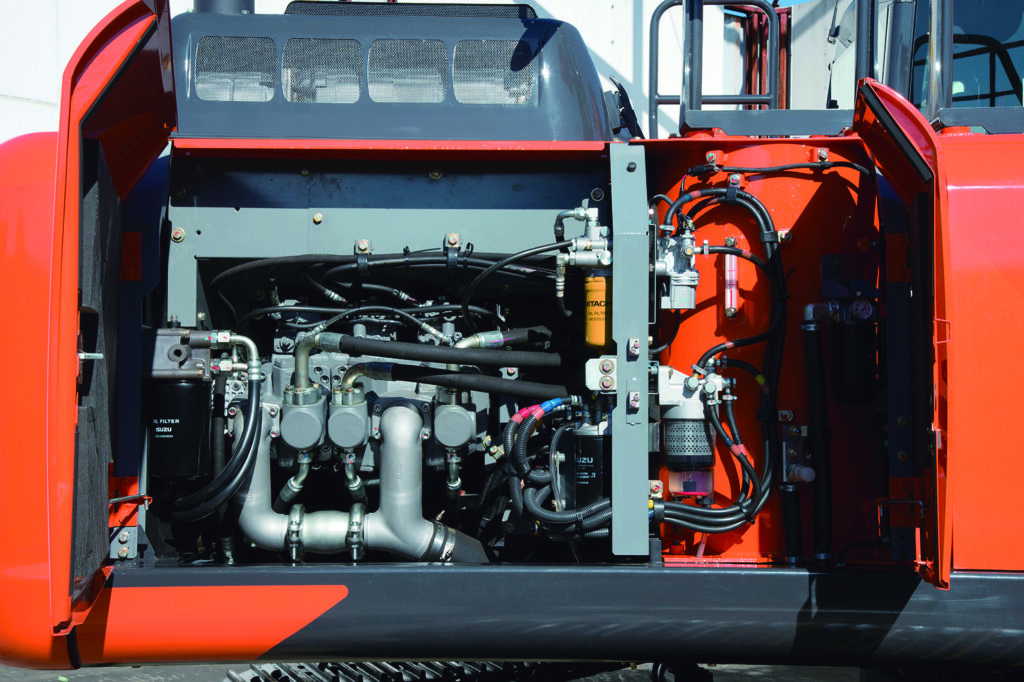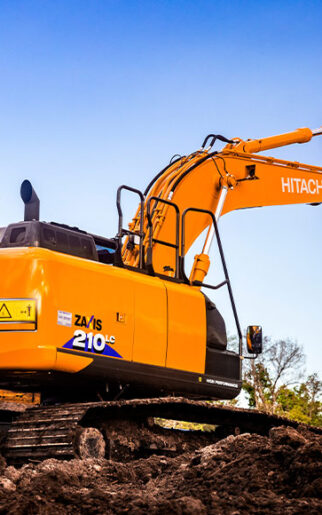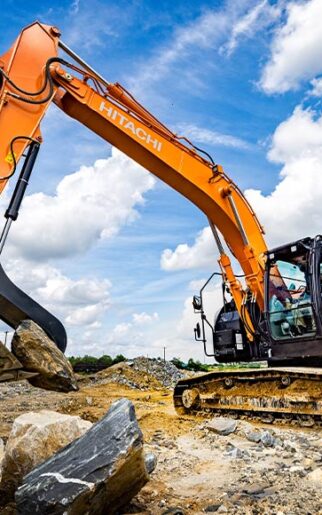Fuel cost is a major consideration for anyone operating a larger excavator. It can often account for the largest portion of the ownership cost, especially when looking at 20-ton (18.14 metric ton) and larger excavators. Fuel efficiency plays an important role in the total cost of ownership. To maximize your bottom line, you want a machine that offers superior performance and responsiveness while consuming less fuel. Speed and productivity can help shorten timelines and ensure jobs stay on track.
To increase fuel efficiency, excavator manufacturers typically concentrate on the engine by lowering engine speed in light or normal working conditions. But this can negatively affect the feel and responsiveness of the machine. Hitachi takes a unique approach by concentrating on excavator hydraulic system efficiency instead.
Hitachi engineers have stepped up to the challenge with the TRIAS excavator hydraulic system. It is engineered with three pumps to maximize productivity while using as little fuel as possible and maintaining precise and responsive operator controls. This design has allowed Hitachi to build a reputation on the speed of the front attachment.
The TRIAS excavator hydraulic system was initially developed in 2011. It replaces the two-pump hydraulic system commonly used throughout the excavator industry. The third pump contributes flow to several of the main actuators, giving priority to the swing circuit. Fine-tuned control valve spools, multiple pressure sensors and computer-controlled solenoid valves maximize efficiency and multifunctional productivity without sacrificing fuel economy.
There are losses inherent to all hydraulic systems. The TRIAS hydraulic excavator system was engineered to reduce losses that occur during spool or valve operation. When a portion of a pressurized hydraulic pump flow output is directed to an actuator, the other portion of the pressurized pump flow is diverted back to the oil tank. The pressurized oil flow directed to the actuator produces usable hydraulic power. The pressurized oil flow directed to the tank is lost hydraulic power. This hydraulic-system inefficiency also results in higher oil temperatures, which can be detrimental to both oil and component life.
Reducing the amount of pressurized oil returned to the oil tank increases overall system efficiency. When the Hitachi ZX250 excavator is running in power mode, the TRIAS system has been reported to reduce fuel consumption by 9%.
The TRIAS II system advances efficiency even further than the original design by fine-tuning the control valve spools and adding additional pump-flow-limit solenoid valves. This reduces hydraulic losses in the control valve during less than maximum lever operation. The control valve spools have been tuned to restrict oil flow to the tank during small and medium control lever strokes. Less pressurized oil flows back to the tank, reducing the amount of lost energy. When the Hitachi ZX250 excavator is running in power mode, the TRIAS II system reduces fuel consumption by an additional 10% over the machine equipped with the original TRIAS technology.
TRIAS II debuts in North America
On May 20, 2022, Hitachi Construction Machinery Americas (HCMA) introduced the 50,265-lb (22,800-kg) ZX210LC-6 HP excavator in North America. It offers best-in-class power and speed and is the first Hitachi-built excavator in North America to feature the TRIAS II hydraulic system. The previous generation machine, built through a joint-venture agreement, used a two-pump hydraulic system.
The improved TRIAS II excavator hydraulic system supplies an optimal amount of pressurized oil to each actuator on the Hitachi ZX210LC-6 HP. “The TRIAS II uses three hydraulic pumps to send oil where it needs to be, when it needs to be there — making it very efficient,” said HCMA Director of Product Management and Engineering Rob Orlowski.
To help drive performance, the ZX210LC-6 HP also includes an arm recirculation cancellation system for increased speed when rolling the arm in. The system allows pressurized oil in the cylinder rod side to flow to the arm cylinder bottom side for increased roll-in speed when the load is relatively low. A hydraulic boost system increases arm speed. During arm roll-in and boom-raising operations, excessive pressurized oil in the boom rod flows to the arm cylinder bottom side to achieve speedy operation by increasing flow. An enhanced boom recirculation system circulates pressurized oil in the bottom of the boom cylinder when lowering the boom, allowing pressurized oil from the pump to be efficiently used by the arm.
A high-power HP Mode increases engine speed and hydraulic-pump output torque when extra speed and/or heavy-duty work is required. The front attachment moves faster because each actuator has its own pump. The oil flows separately to the bucket, arm and boom cylinders.
The engine uses an electronic governor to maintain a constant speed despite changes to the load. This can reduce fuel consumption and sound output in no-load and light-duty operations.
Looking toward the future, the TRIAS hydraulic system is essential to the performance of Hitachi excavators. “I have been in the industry for 25 years,” Orlowski explained. “When I sat down with the team and went over the ZX210LC-6 HP excavator features and specifications, I said, ‘that’s a beast.’”
Experience the difference of the TRIAS II excavator hydraulic system on your toughest jobs with the Hitachi ZX210LC-6 HP excavator. Request a demo today!





